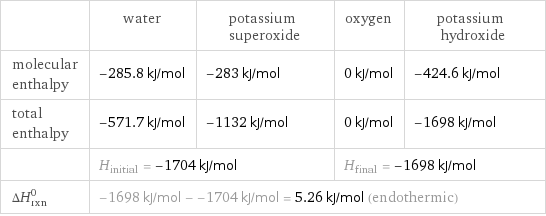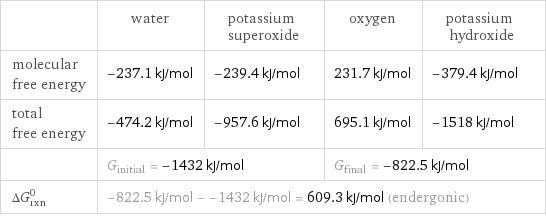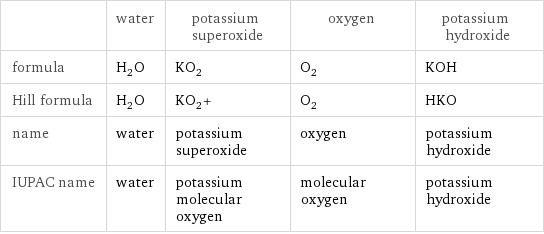Input interpretation

H_2O water + KO_2 potassium superoxide ⟶ O_2 oxygen + KOH potassium hydroxide
Balanced equation

Balance the chemical equation algebraically: H_2O + KO_2 ⟶ O_2 + KOH Add stoichiometric coefficients, c_i, to the reactants and products: c_1 H_2O + c_2 KO_2 ⟶ c_3 O_2 + c_4 KOH Set the number of atoms in the reactants equal to the number of atoms in the products for H, O and K: H: | 2 c_1 = c_4 O: | c_1 + 2 c_2 = 2 c_3 + c_4 K: | c_2 = c_4 Since the coefficients are relative quantities and underdetermined, choose a coefficient to set arbitrarily. To keep the coefficients small, the arbitrary value is ordinarily one. For instance, set c_1 = 1 and solve the system of equations for the remaining coefficients: c_1 = 1 c_2 = 2 c_3 = 3/2 c_4 = 2 Multiply by the least common denominator, 2, to eliminate fractional coefficients: c_1 = 2 c_2 = 4 c_3 = 3 c_4 = 4 Substitute the coefficients into the chemical reaction to obtain the balanced equation: Answer: | | 2 H_2O + 4 KO_2 ⟶ 3 O_2 + 4 KOH
Structures

+ ⟶ +
Names

water + potassium superoxide ⟶ oxygen + potassium hydroxide
Reaction thermodynamics
Enthalpy

| water | potassium superoxide | oxygen | potassium hydroxide molecular enthalpy | -285.8 kJ/mol | -283 kJ/mol | 0 kJ/mol | -424.6 kJ/mol total enthalpy | -571.7 kJ/mol | -1132 kJ/mol | 0 kJ/mol | -1698 kJ/mol | H_initial = -1704 kJ/mol | | H_final = -1698 kJ/mol | ΔH_rxn^0 | -1698 kJ/mol - -1704 kJ/mol = 5.26 kJ/mol (endothermic) | | |
Gibbs free energy

| water | potassium superoxide | oxygen | potassium hydroxide molecular free energy | -237.1 kJ/mol | -239.4 kJ/mol | 231.7 kJ/mol | -379.4 kJ/mol total free energy | -474.2 kJ/mol | -957.6 kJ/mol | 695.1 kJ/mol | -1518 kJ/mol | G_initial = -1432 kJ/mol | | G_final = -822.5 kJ/mol | ΔG_rxn^0 | -822.5 kJ/mol - -1432 kJ/mol = 609.3 kJ/mol (endergonic) | | |
Entropy

| water | potassium superoxide | oxygen | potassium hydroxide molecular entropy | 69.91 J/(mol K) | 117 J/(mol K) | 205 J/(mol K) | 79 J/(mol K) total entropy | 139.8 J/(mol K) | 468 J/(mol K) | 615 J/(mol K) | 316 J/(mol K) | S_initial = 607.8 J/(mol K) | | S_final = 931 J/(mol K) | ΔS_rxn^0 | 931 J/(mol K) - 607.8 J/(mol K) = 323.2 J/(mol K) (endoentropic) | | |
Equilibrium constant
![Construct the equilibrium constant, K, expression for: H_2O + KO_2 ⟶ O_2 + KOH Plan: • Balance the chemical equation. • Determine the stoichiometric numbers. • Assemble the activity expression for each chemical species. • Use the activity expressions to build the equilibrium constant expression. Write the balanced chemical equation: 2 H_2O + 4 KO_2 ⟶ 3 O_2 + 4 KOH Assign stoichiometric numbers, ν_i, using the stoichiometric coefficients, c_i, from the balanced chemical equation in the following manner: ν_i = -c_i for reactants and ν_i = c_i for products: chemical species | c_i | ν_i H_2O | 2 | -2 KO_2 | 4 | -4 O_2 | 3 | 3 KOH | 4 | 4 Assemble the activity expressions accounting for the state of matter and ν_i: chemical species | c_i | ν_i | activity expression H_2O | 2 | -2 | ([H2O])^(-2) KO_2 | 4 | -4 | ([KO2])^(-4) O_2 | 3 | 3 | ([O2])^3 KOH | 4 | 4 | ([KOH])^4 The equilibrium constant symbol in the concentration basis is: K_c Mulitply the activity expressions to arrive at the K_c expression: Answer: | | K_c = ([H2O])^(-2) ([KO2])^(-4) ([O2])^3 ([KOH])^4 = (([O2])^3 ([KOH])^4)/(([H2O])^2 ([KO2])^4)](../image_source/963552a85d5f03c1412332a57e9035be.png)
Construct the equilibrium constant, K, expression for: H_2O + KO_2 ⟶ O_2 + KOH Plan: • Balance the chemical equation. • Determine the stoichiometric numbers. • Assemble the activity expression for each chemical species. • Use the activity expressions to build the equilibrium constant expression. Write the balanced chemical equation: 2 H_2O + 4 KO_2 ⟶ 3 O_2 + 4 KOH Assign stoichiometric numbers, ν_i, using the stoichiometric coefficients, c_i, from the balanced chemical equation in the following manner: ν_i = -c_i for reactants and ν_i = c_i for products: chemical species | c_i | ν_i H_2O | 2 | -2 KO_2 | 4 | -4 O_2 | 3 | 3 KOH | 4 | 4 Assemble the activity expressions accounting for the state of matter and ν_i: chemical species | c_i | ν_i | activity expression H_2O | 2 | -2 | ([H2O])^(-2) KO_2 | 4 | -4 | ([KO2])^(-4) O_2 | 3 | 3 | ([O2])^3 KOH | 4 | 4 | ([KOH])^4 The equilibrium constant symbol in the concentration basis is: K_c Mulitply the activity expressions to arrive at the K_c expression: Answer: | | K_c = ([H2O])^(-2) ([KO2])^(-4) ([O2])^3 ([KOH])^4 = (([O2])^3 ([KOH])^4)/(([H2O])^2 ([KO2])^4)
Rate of reaction
![Construct the rate of reaction expression for: H_2O + KO_2 ⟶ O_2 + KOH Plan: • Balance the chemical equation. • Determine the stoichiometric numbers. • Assemble the rate term for each chemical species. • Write the rate of reaction expression. Write the balanced chemical equation: 2 H_2O + 4 KO_2 ⟶ 3 O_2 + 4 KOH Assign stoichiometric numbers, ν_i, using the stoichiometric coefficients, c_i, from the balanced chemical equation in the following manner: ν_i = -c_i for reactants and ν_i = c_i for products: chemical species | c_i | ν_i H_2O | 2 | -2 KO_2 | 4 | -4 O_2 | 3 | 3 KOH | 4 | 4 The rate term for each chemical species, B_i, is 1/ν_i(Δ[B_i])/(Δt) where [B_i] is the amount concentration and t is time: chemical species | c_i | ν_i | rate term H_2O | 2 | -2 | -1/2 (Δ[H2O])/(Δt) KO_2 | 4 | -4 | -1/4 (Δ[KO2])/(Δt) O_2 | 3 | 3 | 1/3 (Δ[O2])/(Δt) KOH | 4 | 4 | 1/4 (Δ[KOH])/(Δt) (for infinitesimal rate of change, replace Δ with d) Set the rate terms equal to each other to arrive at the rate expression: Answer: | | rate = -1/2 (Δ[H2O])/(Δt) = -1/4 (Δ[KO2])/(Δt) = 1/3 (Δ[O2])/(Δt) = 1/4 (Δ[KOH])/(Δt) (assuming constant volume and no accumulation of intermediates or side products)](../image_source/6976bce2834108075e8b13d1a0171711.png)
Construct the rate of reaction expression for: H_2O + KO_2 ⟶ O_2 + KOH Plan: • Balance the chemical equation. • Determine the stoichiometric numbers. • Assemble the rate term for each chemical species. • Write the rate of reaction expression. Write the balanced chemical equation: 2 H_2O + 4 KO_2 ⟶ 3 O_2 + 4 KOH Assign stoichiometric numbers, ν_i, using the stoichiometric coefficients, c_i, from the balanced chemical equation in the following manner: ν_i = -c_i for reactants and ν_i = c_i for products: chemical species | c_i | ν_i H_2O | 2 | -2 KO_2 | 4 | -4 O_2 | 3 | 3 KOH | 4 | 4 The rate term for each chemical species, B_i, is 1/ν_i(Δ[B_i])/(Δt) where [B_i] is the amount concentration and t is time: chemical species | c_i | ν_i | rate term H_2O | 2 | -2 | -1/2 (Δ[H2O])/(Δt) KO_2 | 4 | -4 | -1/4 (Δ[KO2])/(Δt) O_2 | 3 | 3 | 1/3 (Δ[O2])/(Δt) KOH | 4 | 4 | 1/4 (Δ[KOH])/(Δt) (for infinitesimal rate of change, replace Δ with d) Set the rate terms equal to each other to arrive at the rate expression: Answer: | | rate = -1/2 (Δ[H2O])/(Δt) = -1/4 (Δ[KO2])/(Δt) = 1/3 (Δ[O2])/(Δt) = 1/4 (Δ[KOH])/(Δt) (assuming constant volume and no accumulation of intermediates or side products)
Chemical names and formulas

| water | potassium superoxide | oxygen | potassium hydroxide formula | H_2O | KO_2 | O_2 | KOH Hill formula | H_2O | KO_2+ | O_2 | HKO name | water | potassium superoxide | oxygen | potassium hydroxide IUPAC name | water | potassium molecular oxygen | molecular oxygen | potassium hydroxide
Substance properties

| water | potassium superoxide | oxygen | potassium hydroxide molar mass | 18.015 g/mol | 71.096 g/mol | 31.998 g/mol | 56.105 g/mol phase | liquid (at STP) | solid (at STP) | gas (at STP) | solid (at STP) melting point | 0 °C | 560 °C | -218 °C | 406 °C boiling point | 99.9839 °C | | -183 °C | 1327 °C density | 1 g/cm^3 | 2.14 g/cm^3 | 0.001429 g/cm^3 (at 0 °C) | 2.044 g/cm^3 solubility in water | | decomposes | | soluble surface tension | 0.0728 N/m | | 0.01347 N/m | dynamic viscosity | 8.9×10^-4 Pa s (at 25 °C) | | 2.055×10^-5 Pa s (at 25 °C) | 0.001 Pa s (at 550 °C) odor | odorless | | odorless |
Units
